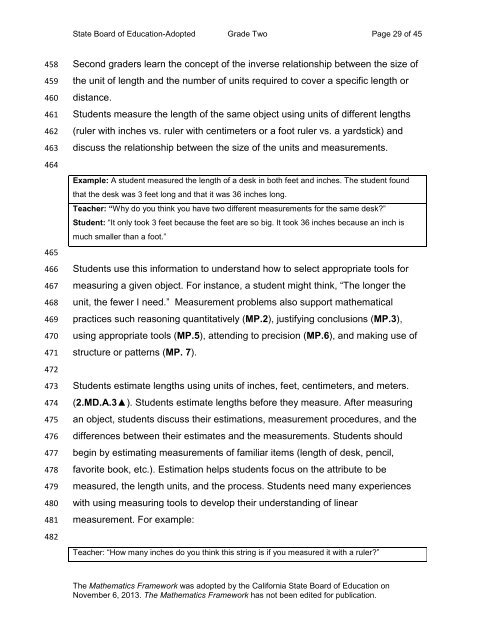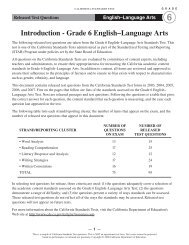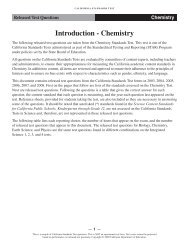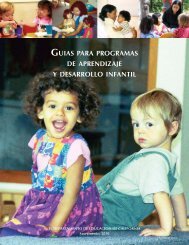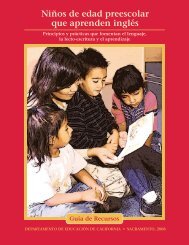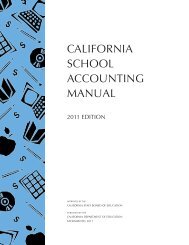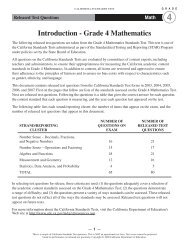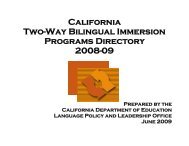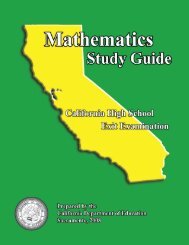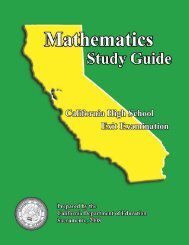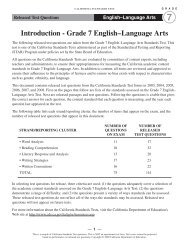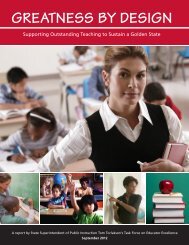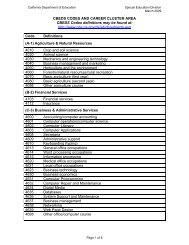Grade 2 - California Department of Education
Grade 2 - California Department of Education
Grade 2 - California Department of Education
Create successful ePaper yourself
Turn your PDF publications into a flip-book with our unique Google optimized e-Paper software.
State Board <strong>of</strong> <strong>Education</strong>-Adopted <strong>Grade</strong> Two Page 29 <strong>of</strong> 45<br />
458<br />
459<br />
460<br />
461<br />
462<br />
463<br />
464<br />
465<br />
466<br />
467<br />
468<br />
469<br />
470<br />
471<br />
472<br />
473<br />
474<br />
475<br />
476<br />
477<br />
478<br />
479<br />
480<br />
481<br />
482<br />
Second graders learn the concept <strong>of</strong> the inverse relationship between the size <strong>of</strong><br />
the unit <strong>of</strong> length and the number <strong>of</strong> units required to cover a specific length or<br />
distance.<br />
Students measure the length <strong>of</strong> the same object using units <strong>of</strong> different lengths<br />
(ruler with inches vs. ruler with centimeters or a foot ruler vs. a yardstick) and<br />
discuss the relationship between the size <strong>of</strong> the units and measurements.<br />
Example: A student measured the length <strong>of</strong> a desk in both feet and inches. The student found<br />
that the desk was 3 feet long and that it was 36 inches long.<br />
Teacher: “Why do you think you have two different measurements for the same desk?”<br />
Student: “It only took 3 feet because the feet are so big. It took 36 inches because an inch is<br />
much smaller than a foot.”<br />
Students use this information to understand how to select appropriate tools for<br />
measuring a given object. For instance, a student might think, “The longer the<br />
unit, the fewer I need.” Measurement problems also support mathematical<br />
practices such reasoning quantitatively (MP.2), justifying conclusions (MP.3),<br />
using appropriate tools (MP.5), attending to precision (MP.6), and making use <strong>of</strong><br />
structure or patterns (MP. 7).<br />
Students estimate lengths using units <strong>of</strong> inches, feet, centimeters, and meters.<br />
(2.MD.A.3▲). Students estimate lengths before they measure. After measuring<br />
an object, students discuss their estimations, measurement procedures, and the<br />
differences between their estimates and the measurements. Students should<br />
begin by estimating measurements <strong>of</strong> familiar items (length <strong>of</strong> desk, pencil,<br />
favorite book, etc.). Estimation helps students focus on the attribute to be<br />
measured, the length units, and the process. Students need many experiences<br />
with using measuring tools to develop their understanding <strong>of</strong> linear<br />
measurement. For example:<br />
Teacher: “How many inches do you think this string is if you measured it with a ruler?”<br />
The Mathematics Framework was adopted by the <strong>California</strong> State Board <strong>of</strong> <strong>Education</strong> on<br />
November 6, 2013. The Mathematics Framework has not been edited for publication.


